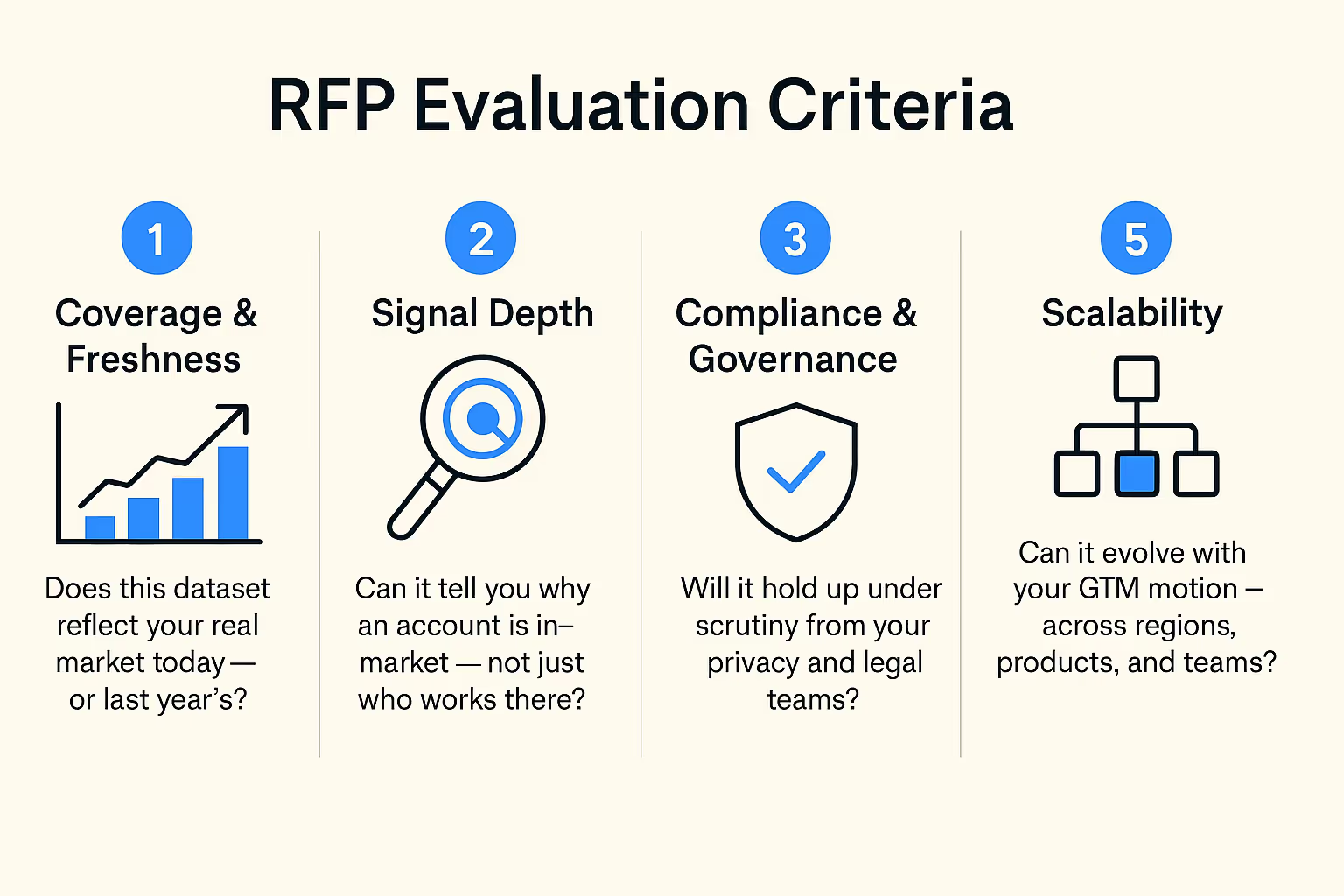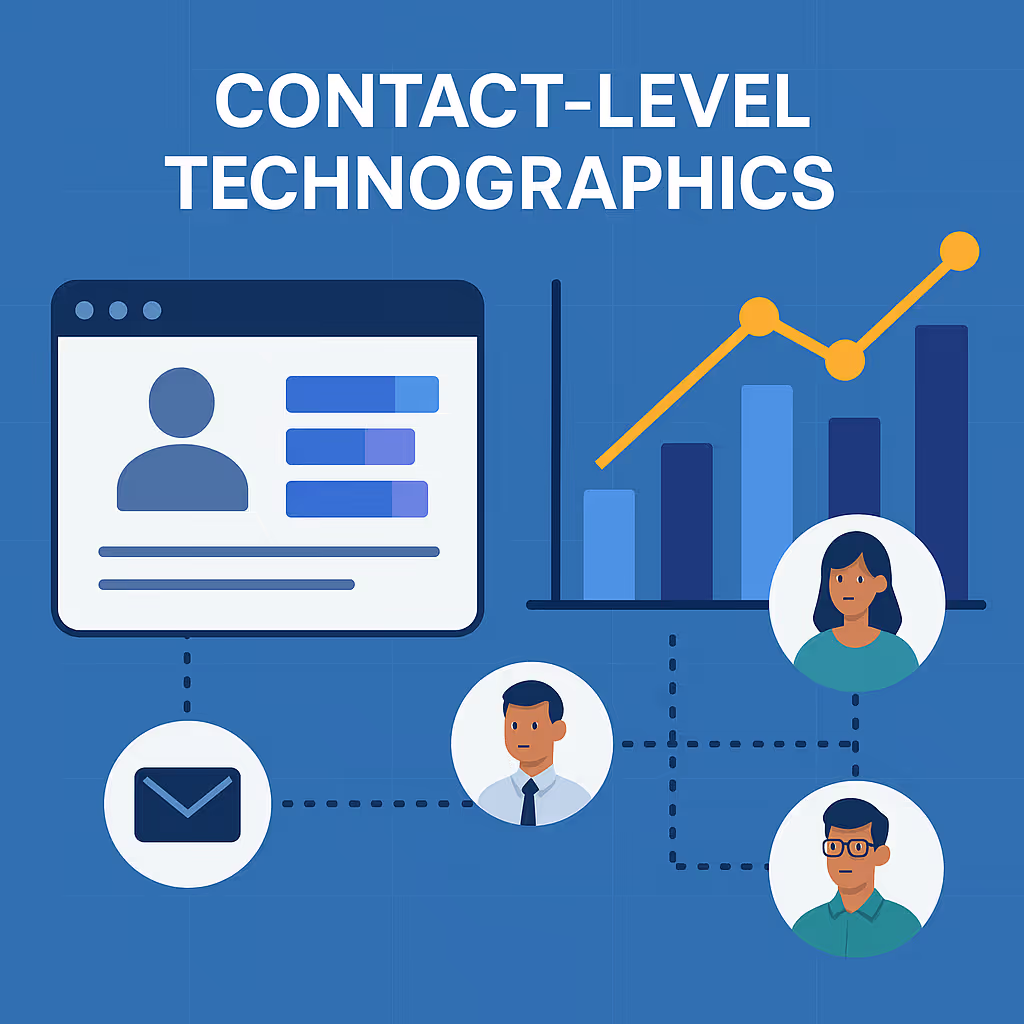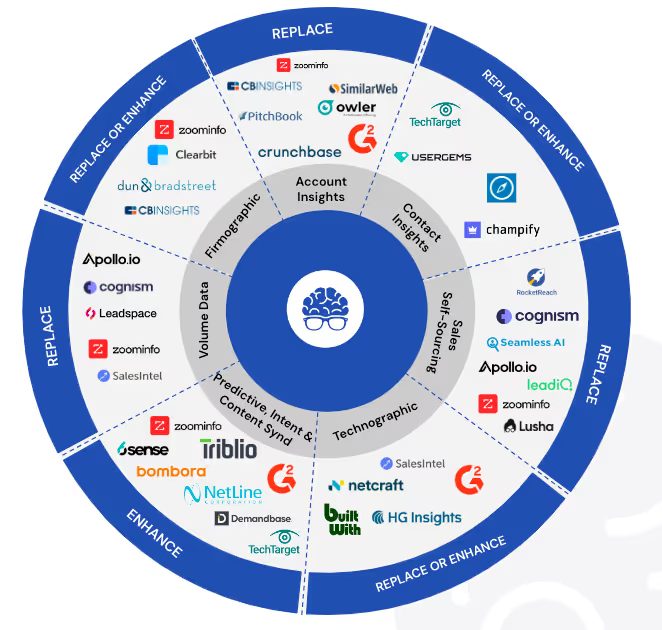If you’re in Sales Ops, Marketing Ops, or RevOps, chances are you’ve been “volunteered” to lead a data vendor evaluation.
Translation: You’re about to spend the next 6 weeks explaining to everyone in your org why bad data isn’t just an annoyance — it’s a pipeline killer.
And let’s be honest — most RFPs start off the same way:
“We need to replace ZoomInfo with something better.”
But the truth is, this isn’t just a replacement exercise. It’s an opportunity to redefine how your entire GTM motion runs.
Because the quality, freshness, and fit of your data determines everything — from which accounts get touched, to how your SDRs prioritize, to whether your campaigns actually convert.
So if you’re evaluating data partners for accounts, contacts, and buying signals, here are the five vendors you owe it to yourself to include in that evaluation — with a clear-eyed look at where each succeeds, and where each struggles.
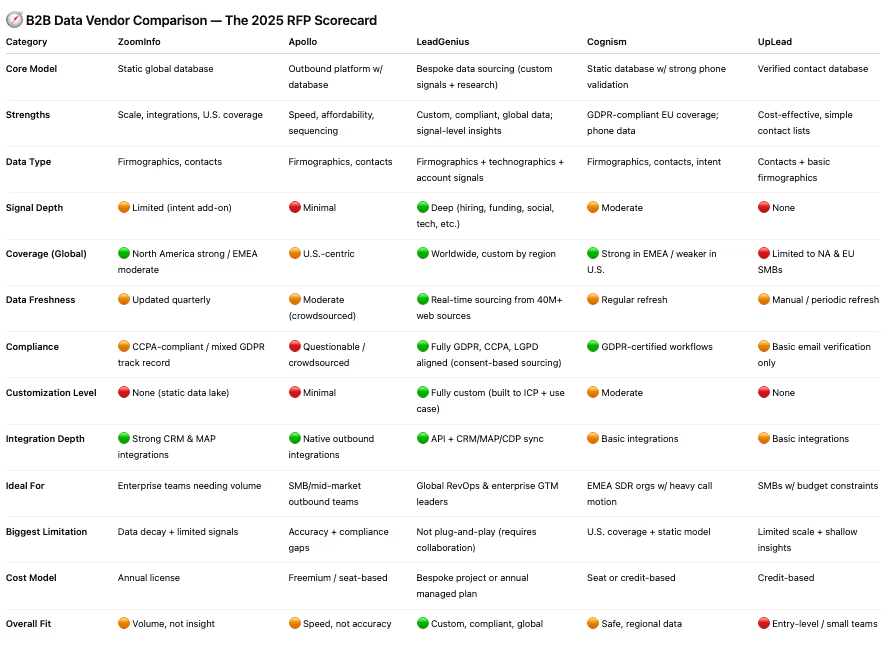
1. ZoomInfo — The Default Starting Point (and the Legacy Benchmark)
Where They Succeed:
ZoomInfo has set the standard for static B2B data. Their platform offers breadth — millions of companies, contact details, and integrations across every major CRM and marketing tool. For many teams, it’s the “easy button” for basic contact enrichment, org charts, and company info.
Where They Struggle:
The problem is, it’s a leased database, not a living ecosystem. Data freshness decays fast, and contacts that look great in dashboards can bounce at 30% or more in real campaigns. Coverage outside North America is limited, and compliance scrutiny (especially around GDPR and CCPA) continues to rise.
When you need custom, real-time insights — think hiring signals, funding events, or role-level tech usage — ZoomInfo can’t deliver.
2. LeadGenius — The Bespoke Intelligence Partner
Where They Succeed:
LeadGenius is the antidote to static databases — the opposite of the “rent-a-dataset” model that tools like ZoomInfo and Apollo have normalized.
Instead of giving you a login to the same data lake as every other company in your industry, LeadGenius builds custom, real-time datasets and account signals that mirror your ideal customer profile.
They combine AI-driven automation with human research — a powerful hybrid model that continuously sources data from over 40 million live web sources. That includes technographics, hiring trends, funding and ownership changes, e-commerce and supply chain insights, new product launches, social presence, and executive movements.
Where static tools stop at “firmographics,” LeadGenius goes deeper — pulling context. Who’s expanding into the U.S. market? Which accounts just hired a Head of Revenue Ops? Who’s adopting your integration partner’s tech stack? Which subsidiaries just launched a new product line?
That’s not enrichment — that’s market intelligence.
This makes LeadGenius ideal for enterprise and global GTM teams running complex, multi-segment, or multi-region strategies. Think of companies like SAP, Amazon, and Microsoft — organizations that can’t rely on one-size-fits-all data to fuel specialized campaigns.
LeadGenius delivers bespoke coverage, compliance, and clarity, giving marketing and sales teams a synchronized, real-time view of their total market — not just a list of names.
It’s also one of the few providers capable of handling the data maturity needs of modern RevOps teams — custom hierarchies, global taxonomies, regional normalization, and automated integration into CRMs, CDPs, or data lakes.
Put simply: LeadGenius doesn’t just give you data.
It gives you signal-rich intelligence, purpose-built to scale your revenue operations.
Where They Struggle:
LeadGenius isn’t a plug-and-play experience — and that’s by design.
You’re not buying a product; you’re forming a data partnership.
That means it requires some upfront collaboration — defining your ICP, aligning on data taxonomies, integrating systems, and setting up feedback loops. Onboarding can take a little longer than a simple ZoomInfo login, but the tradeoff is meaningful: what you get is clean, compliant, and continuously updated data built for you, not for the masses.
It’s the classic “chef versus cafeteria” comparison — you trade a little convenience for quality, precision, and performance.
For fast-scaling companies running multi-region, multi-product GTM motions, this level of customization is exactly what turns data from a cost center into a competitive advantage.
3. Apollo.io — The Speed and Affordability Play
Where They Succeed:
Apollo exploded in popularity because of its all-in-one outbound platform — blending email sequencing, enrichment, and lightweight CRM functionality into one accessible tool. For small and mid-market teams, it’s cost-effective, fast to onboard, and integrates easily into a scrappy GTM motion.
Where They Struggle:
Data accuracy is inconsistent, and the “cheap seat” pricing hides a real tax: time wasted validating bounced emails and inaccurate company data. Apollo shines as a productivity platform, not as a data source.
If you’re running a high-velocity, high-volume motion — it works. But for strategic account-based or enterprise campaigns, you’ll find the limitations quickly.
4. Cognism — The Compliance-First Challenger
Where They Succeed:
Cognism’s biggest strength is compliance and coverage in EMEA. They’ve built deep GDPR processes and direct consent frameworks that appeal to privacy-conscious organizations. Their phone-number data is notably strong, making them a good fit for SDR teams with heavy calling motions in Europe.
Where They Struggle:
Cognism’s contact depth and account insights in North America can’t yet match ZoomInfo or LeadGenius. And while they’ve positioned themselves as a modern alternative, they still operate on a prebuilt database model — meaning freshness and customization are limited.
5. UpLead — The SMB Precision Player
Where They Succeed:
UpLead is a solid option for SMB and mid-market teams that need basic, verified contact data with decent accuracy. They focus heavily on validation (their “95% accuracy guarantee” is their core pitch), and for smaller teams, it’s a cost-conscious way to get a clean starting list.
Where They Struggle:
UpLead lacks advanced firmographic intelligence, signals, or global coverage. You won’t find dynamic intent data, tech install detection, or custom sourcing. It’s ideal for small-scale prospecting — but limited for RevOps teams needing dynamic, multi-signal data to fuel ABM or global GTM programs.
The Biggest Mistake Teams Make When Running a Data RFP
Most teams treat a data RFP like a procurement exercise.
They issue an RFP, chase the lowest CPM, compare a few CSV samples, and call it a day.
But that mindset misses the entire point.
Because data isn’t a line item — it’s your go-to-market operating system.
Every territory plan, campaign, and pipeline forecast is built on top of it.
So if your data isn’t shaping who you sell to, when you engage, and how you prioritize, then you don’t have a data strategy…
You just have another subscription.
A true data strategy doesn’t start with volume — it starts with fit.
The right data should reveal your real Total Addressable Market (TAM), uncover growth signals that static tools miss, and fuel every system — CRM, MAP, CDP — with intelligence that moves the business forward.
So when you’re building your evaluation matrix, skip the vanity metrics and look through the lenses that actually drive growth and alignment:
1. Coverage & Freshness
Does this dataset reflect your real market today — or last year’s?
Markets evolve weekly. Subsidiaries spin up. New competitors enter. If your data vendor updates quarterly, you’re already selling to ghosts.
2. Signal Depth
Can it tell you why an account is in-market — not just who works there?
Look for behavioral, operational, and hiring signals that reveal true buying readiness. Static firmographics are the past. Account signals are the future.
3. Compliance & Governance
Will it hold up under scrutiny from your privacy and legal teams?
GDPR, CCPA, and LGPD aren’t checkboxes anymore — they’re business risks. Make sure your vendor isn’t just “compliant by claim” but can show consent provenance and data lineage.
4. Integration & Workflow Fit
Can it sync seamlessly into your CRM, MAP, or data lake without breaking existing automations?
The best data in the world is useless if it can’t flow into Salesforce, HubSpot, or Marketo cleanly. Data must accelerate your process, not create new friction.
5. Scalability
Can it evolve with your GTM motion — across regions, products, and teams?
You might start with U.S. outbound data, but tomorrow you’ll need EMEA signals, APAC contacts, or partner-level intelligence. Your data foundation should scale as your business does.
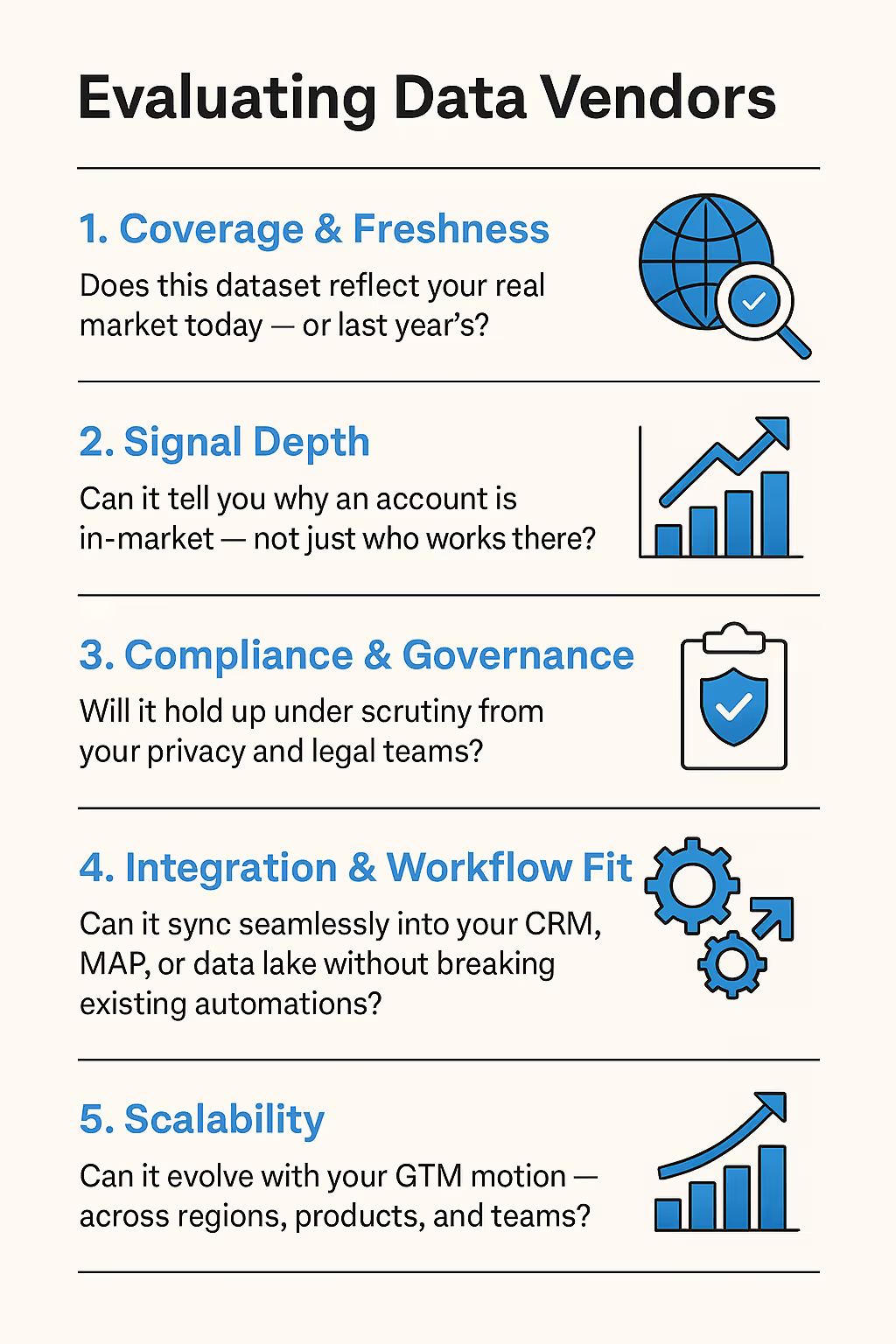
Final Thought: The Future Belongs to Bespoke Data
Every RevOps or Marketing Ops leader knows — the world has changed.
We’re not living in a “database” era anymore; we’re living in a signal economy.
ZoomInfo, Apollo, Cognism, and UpLead all have their strengths.
But if you’re serious about global coverage, compliance, and custom intelligence that aligns marketing, sales, and RevOps — LeadGenius deserves a spot in your RFP shortlist.
Because the future of growth doesn’t belong to whoever has the most data.
It belongs to whoever has the most relevant data — delivered exactly when and where you need it.

